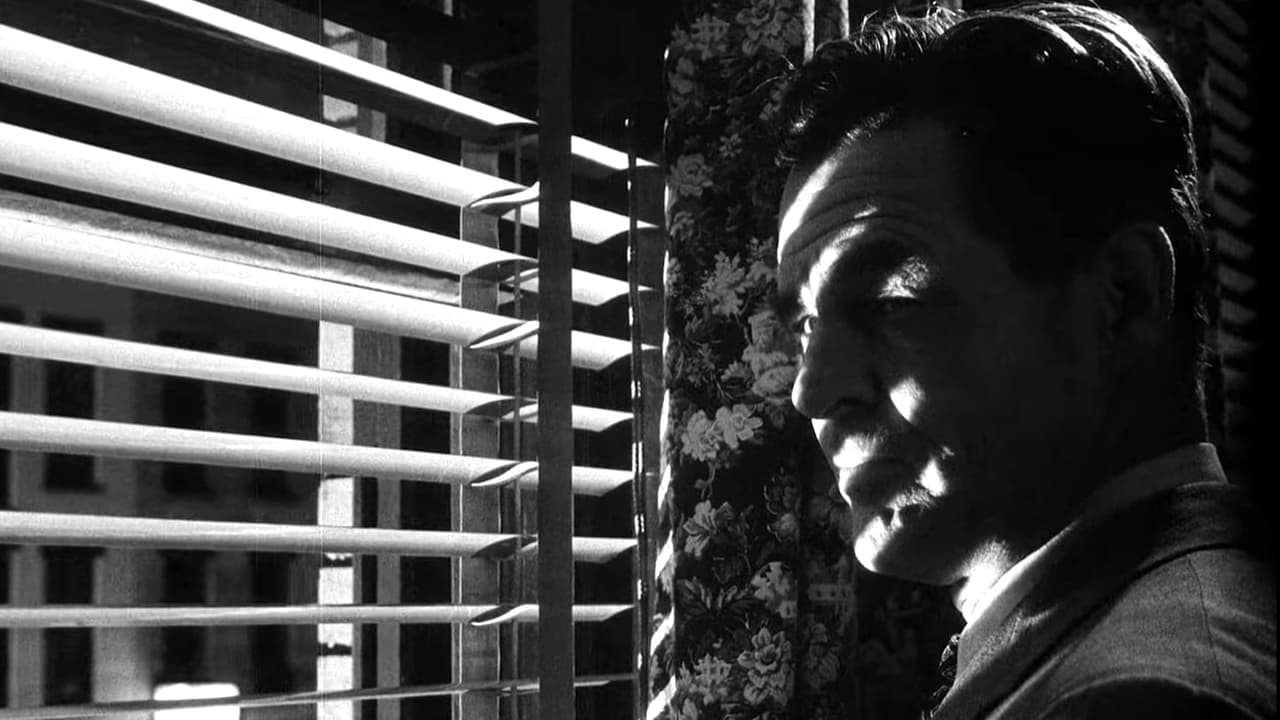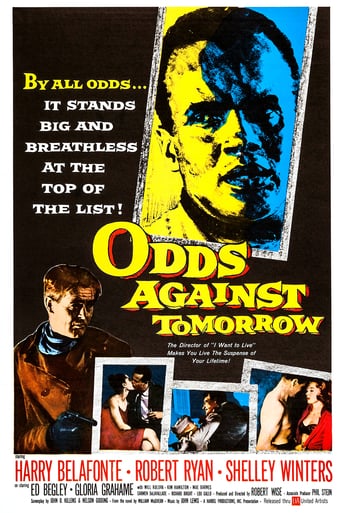



Horrible, fascist and poorly acted
A brilliant film that helped define a genre
This movie tries so hard to be funny, yet it falls flat every time. Just another example of recycled ideas repackaged with women in an attempt to appeal to a certain audience.
View MoreI enjoyed watching this film and would recommend other to give it a try , (as I am) but this movie, although enjoyable to watch due to the better than average acting fails to add anything new to its storyline that is all too familiar to these types of movies.
View More"You didn't say nothing 'bout the third man being a n*gger." That cold sun glares not only on the wintry New York streets, but also in the dialogues of Robert Wise's Odds Against Tomorrow, a noir implying to be about a bank heist. Actually, it's about the blues, one key scene playing in a nightclub with Harry Belafonte singing When That Cold Sun Goes Down - an intense and intimate performance, and probably the best song Belafonte ever did on or off screen. The tune quasi condenses the mood of the picture, the stark monochrome of the mise en scène, the agonizing rhythm of the doom closing in, and even the cursed melancholia of Robert Ryan's racist character, a rugged, achingly torn individual gone awry; just wait for the scene when he's provoked by some unwitting youngster in a bar. A grim study about desperation, desolation, and self-hate, OAT was a quite discomforting statement, and essentially the project of the man who played more than just the cool dude role here: co-producer Harry Belafonte, who certainly had a special notion of the "Blacklist" he'd been on during the McCarthy reign. In the meantime, he had made a trillion bucks with the godawful Banana Boat Song. Now, finally, he had found something that Day-O money was good for.
View MoreI love the hallucinatory opening credits to this noir/ heist flick, seeing it in a cinema on a big screen.Three men (one of them with several thousand dollars in gambling debt) conspire to steal $200.000 from a small town bank in upstate NY.Robert Ryan is alternately racist and cowardly, watch how quickly he runs away when he gets his feelings hurt. Belafonte is sympathetic in some scenes, appropriately unlikeable in others. The two characters are, understandably, at each other's throats throughout. Ed Begley's ringleader character is mostly just a goofball, albeit one with a memorable death scene. Great jazz score and an abrupt, explosive (literally, and also rather funny) ending caps things off well, after slow pacing in film's second act. Gotta love the bizarre lift, also, and its even more bizarre liftman.
View MoreI thought this was a fine movie but would have liked it better without the contrived ending. How does a large industrial plant blow up from a single gunshot, and from a revolver no less. However the commentary from the ambulance guy regarding the inability to distinguish between a black and white man after being immolated was a clever way to state that underneath, we're all just human beings trying to make our own way in the world.What distracted me from the flow of the story was when Ed Begley's character tried to diffuse the tension between Slater (Robert Ryan) and Johnny (Harry Belafonte) by stating that they both served in the same war. What war would that have been? If you consider the actor's real ages to correspond to their roles, Ryan would have been in his early forties for Korea, while Belafonte would have been in his teens during World War II. Neither scenario theoretically impossible of course, but neither one very likely either. Unless there was another war in between, but then I missed it somehow.I liked this picture. Along with other movies of the era like 1958's "The Defiant Ones" (Curtis and Poitier) and 1967's "In The Heat Of The Night" (Steiger and Poitier again), film makers seemed to be more honest in their portrayals of race relations compared to the political correctness of present day. The tension between Slater and Johnny was palpable of course, but I had the feeling that Ryan's character was more of an equal opportunity hater all around. However Johnny had no qualms about lashing out against his ex (Kim Hamilton) for mingling with whites and attempting a better life for herself and their daughter.Apart from the story itself, I was intrigued by the great location photography of those awesome New York City neighborhoods in the early going. The transition to upstate New York had me fact checking the existence of Melton, but if you take a good look at Slater's map, you'll see the city of Hudson where the filming took place, along with a host of small towns on the way up the State Thruway and branching off into the countryside. Having grown up mid-way between both areas, it made the story that much more accessible for me.As far as the story goes, it serves well on both the noir and caper levels. With it's emphasis on the racial component, the thing that continually intruded was the idea that Belafonte, portraying a generally more enlightened and tolerant person than Ryan's character, wound up fifty plus years later as an overt racist by the way he lashes out in the media in the present day. That's really too bad, as he could much better serve as a role model by recognizing the country has changed for the better over the span of a half century.
View More"Odds Against Tomorrow" embodies and, I suppose, calumniates "film noir" though as a sort of message or propaganda movie. Propaganda here is not pejorative but descriptive even to the extent that the film ends with excellent if blunt irony.I think that I most enjoy the high contrast cinematography by Joseph C. Brun, though, perhaps, none of it is technically innovative. It simply embraces and exploits a rich tradition. I very much liked the scenes shot in Central Park. I enjoy watching this one with the sound off simply to celebrate the look, but an excellent jazz score by John Lewis is another joy.The casting is outstanding. Ed Begley has a stony, rough face that defines the tone of the work. Robert Ryan always distinguishes himself. And Harry Belafonte is well into his campaign to remake America. I love Shelly Winters, especially in a scene when he prepares to go out to work to take care of Slater.Gloria Graham with just an open coat and a black bra with her pout defines sexual vulnerability. We sometimes forget her range. Robert Wise always seem in charge in his films. The screenplay by Abraham Polonsky sounds authentic.There is even an appearance by Wayne Rogers as a soldier in an early performance in his career. I think this is an almost lost classic. It deserves attention.
View More